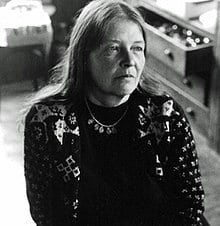
Lynne Mapp Drexler (1928–1999) was born in Newport News, Virginia.She began painting as a child. Later, Drexler took art classes in Virginia at the Richmond Professional Institute and at the College of William & Mary. She moved to New York City in the mid to late 1950s to further her study art under Robert Motherwell at Hunter College and Hans Hofmann, under their tutelage she developed an interest in Abstract Expressionism. Motherwell taught her composition and draftsmanship techniques and the philosophy "that to be an artist meant first and foremost that one had to create work worthy of attention". Her tendency to create vibrant paintings using a free brush stroke was influenced by Hofman and the work of Henri Matisse. Hofman also introduced the notion that composition is influenced by color, which he called the "push-pull" concept.
In the late 1950s, she was an abstract expressionist and was "counted among an important group of women artists whose figural and landscape works were often overlooked during the heyday of post-abstract expressionist modernism – artists such as Jane Freilicher, Lois Dodd, and Jane Wilson."
She would often go to opera and symphony performances with a sketchpad and colored crayons in hand to make sketches inspired by the music.[6][7] Drexler's Pattern and Decoration embroidery and patchwork influenced some of her later works, similar designs often appeared in her painting's backgrounds.
In 1961, Drexler met fellow artist John Hultberg at The Artist's Club in New York. Artists there discussed abstract expressionism. She had her first solo exhibition of eleven works at Tanager Gallery. Drexler and Hultberg were married on May 25, 1962 and for three years they traveled and lived in Mexico, the West Coast and Hawaii. They then lived at New York's Chelsea Hotel in the late 1960s. In an exhibition of seven married couples, Mr. and Mrs. at Alonzo, Drexler's painting "is concerned with juxtaposing diversely patterned areas of vivid colors" while her husband's work was said to reflect "an outer-space, figurative orientation".